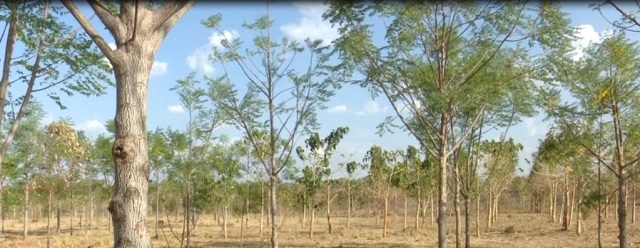
Kampala, Uganda | Isaac Khisa | Simon Opolot, the head teacher of Musupo Primary School in Moroto District, is always in deep thoughts on how to prepare lunch for the pupils.
The children have to walk five kilometers on Mt. Moroto and other neighboring hills at least twice a week to collect firewood.
“It is very tiresome …looking at the long distance to the mountain since there’s no firewood near here,” said Opolot, who works in the Karamoja sub-region north eastern Uganda.
“Providing lunch is very important here, without it, pupils won’t come to school the next day. World Food Programme provides us with food but there’s no firewood to cook since all trees have been cleared to burn charcoal for sale.”
“We therefore begin teaching at least an hour or two late… other pupils deliberately come very late to dodge fetching firewood,” he added, a head of the International Day of Forests, which falls on March 21.
However, good times are seen ahead as the Food and Agriculture Organization of the United Nations’ four- year’s Sawlog Production Grant Scheme, Phase III (SPGS III), stimulates planting of commercial trees in eight clusters countrywide including Karamoja sub-region which Musupo Primary School falls.
Musupo Primary School with 177 pupils has planted more than approximately 1,300 trees on 1.2 hectares of land with the hope that the firewood burden will be eased in the next five or so years.
Other beneficiaries in this project in the Karamoja sub-region include; Lia Primary School, St Mary’s Seminary Nadiket, Katekekile sub county and UPDF 3rd Division.
The Sawlog Production Grant Scheme, Phase III (SPGS III) is a joint initiative of the Ugandan government and the European Union that aims at increasing income of rural populations by promoting investment in commercial tree planting by the private sector and local communities through provision of grants and technical support. It is implemented by the Food and Agriculture Organization of the United Nations (FAO).
With Euro 16 million funding from EU and additional Euro 40,000 from FAO, SPGS III targets establishment of 31,500 hectares of plantations, including: 25,000 hectares by private individuals and companies, 4,000 hectares by small holder community groups and 2,500 hectares of fuel wood plantations by public and private institutions.
In Abim district, Christine Anyait, a former tutor at Bukalasa Agriculture College and now retired, has planted eucalyptus trees in more than 50 acres of land.
Anyait who has benefited from the SPGS both in terms of technical skills and finance, says her interests in tree planting projects is aimed at minimising the impact of climate change as well as job creation.
She said while growing up, Karamoja sub-region had plenty of trees and had some good rainfall but that has all vanished in past decades.
“We have to plant trees as much as possible. We need to embrace the South Korean way in which trees are planted along roads and mountains,” she said, adding that her bold step to plant trees has already started paying off, evidenced with a one-month extension of rainfall to three from now April to June instead of May throughout June annually.
Local residents too, have started embracing growing other food crops such as maize and rice compared with only cassava in the past years.
Dorcus Angole who owns a tree nursery company in Lira district said she has expanded her tree nursery business into Karamoja sub-region.
“I am now working with the NFA and Wetlands Water Institute and already established another tree nursery in the Karamoja sub-region,” she said. “Some of these trees – Teak, Eucalyptus and others can grow well in Karamoja and the tree demand there is increasing,” she said.
Angole, with support from FAO, grows and sales more than 600,000 trees – fruit and non-fruit – to commercial trees planters countrywide earning more than Shs 150 million per season.
Statistics available indicate that East Africa loses about 122,000 hectares annually, and the country’s forest coverage rate reduced from 24 percent to 9 percent between 1990 and 2015.
 The Independent Uganda: You get the Truth we Pay the Price
The Independent Uganda: You get the Truth we Pay the Price



